How to Understand the Narrative Landscape with a Narrative Map

Ever wonder why some messages hit home while others fall flat? It’s not about the story you tell — it’s about what’s already in your audience’s mind. You can be an amazing communicator, but the effectiveness of your communication comes down to if what you say clicks with your audience. So maybe your message isn’t working because it’s lost in the noise.
A tool that’s long been used in the communication world is personas — you know, the fictional characters that are supposed to represent the most important user types in an organization. (David, 48, lives with his St. Bernard in Minneapolis.) Although we’ve been taught to place so much focus on these specific demographic factors, they don’t cut to the core.
Instead, I’m presenting a new solution that invites communicators to visualize and organize the existing beliefs of a person, company, or any group of people and ensure that their message lands with the intended audience. Rather than create personas, a narrative map is an effective way to describe and think deeply about an audience without having to reduce them to a caricature.
In the following blog I will accomplish the following objectives using definitions from my book The Narrative Age:
What’s a narrative map? Let’s break it down.
How can a narrative map shape your business strategy?
Discover how to create a narrative map for your company.
My end goal? To help you compose messages that powerfully and accurately resonate with your audience.
Understanding the power of the narrative Landscape
As many communicators are aware, understanding strategic narrative is the first step in ensuring businesses are aligning core messages with company goals. A strategic narrative is a shared vision of the future that compels action. And it exists within the narrative landscape.
Now let’s break down a few definitions. If you are familiar with my writing, some of this might already be familiar. First, storytelling and narrative are not the same. Stories are specific examples (think the film Rocky) and narratives are more general (consider the overarching idea of the underdog). Why does this distinction matter? Narratives are the unseen force that shapes public perception.
We see ourselves within narratives and can powerfully connect to them on a deep level. When stories are told strategically, they help build compelling narratives. On the other hand, narratives are the patterns that emerge from stories. Understanding the narrative of your company assists with creating a strategic narrative — which can win enormous influence from your audience. Just think — the reason why we root for the character of Rocky is because we identify with the underdog narrative.
The narrative landscape is like the air we breathe — it’s the collection of stories shaping how people see your company, both inside and out. And narrative maps are a way for communicators to organize their messaging, understand the past, and better envision the future.
Exploring the narrative landscape
To better understand how narrative maps operate within the narrative landscape, let’s consider the topic of AI. Ask yourself this — How do you feel about artificial intelligence tools?
While many of us embrace them, there is also an air of apprehension surrounding their increased popularity and accessibility. Why is this? Consider the stories surrounding AI, such as film depictions ranging from The Stepford Wives to Resident Evil to I, Robot. The overarching narrative this has created is that no matter how appealing AI seems, there is still mistrust.
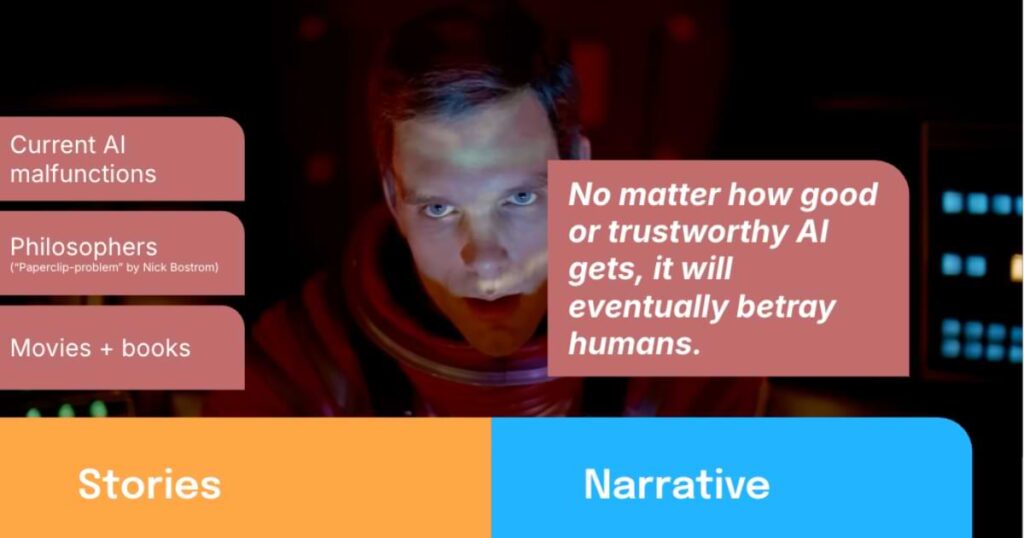
As you can see, the combination of stories that come together to create a narrative has an enormous influence on public opinion. Every story you hear strengthens a narrative’s grip on your beliefs. Furthermore, they are the basis for action.
So as you can see, strategically creating narratives is a true communications superpower. It gives us the ability to sway an audience and make them root for a character, company, or product — or it can cause a lingering air of distrust, fear, and apprehension when it is out of our control. That’s why companies must understand and control their narratives.
Types of narratives in a strategic narrative map
Now that we understand the narrative landscape, let’s dive into how narrative maps can give you a competitive edge. Creating a narrative map is the ultimate to communications can use to control the narratives surrounding their companies.
A narrative map is a strategic tool used to analyze and organize the various stories and narratives surrounding a particular subject, organization, or situation. Think of it as your blueprint for influence. It helps to understand the existing narratives within a specific audience and identify how they align or conflict with the desired messaging.
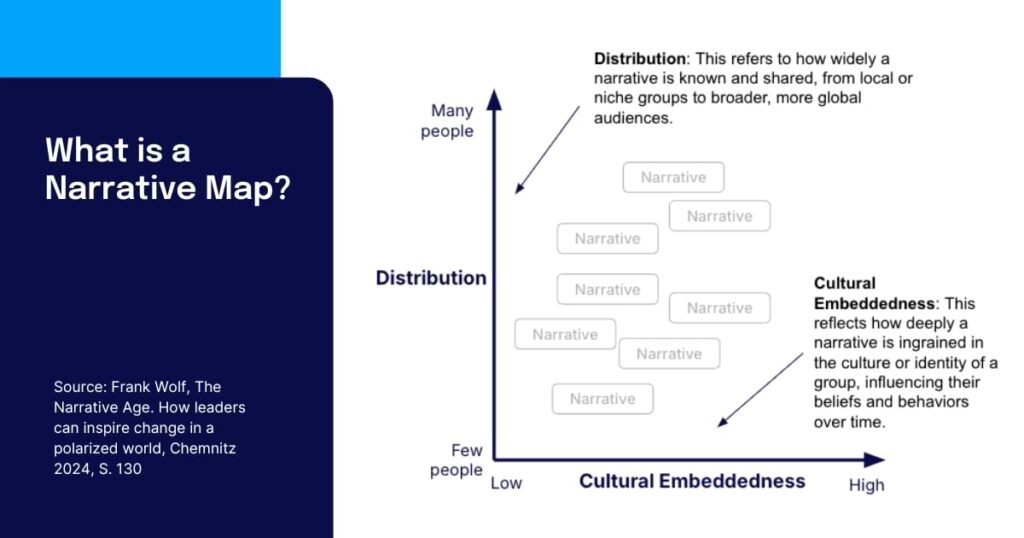
Within narrative maps, I have named four main kinds of narratives. These are:
Emerging narratives: new or recent stories that are gaining wider attention but have not yet become deeply embedded in a culture or widely accepted by a large group
Master narratives: deeply ingrained, culturally shared stories that guide how to behave, think, and live within a society
Local narratives: specific to a particular group, community, or region, often reflecting unique experiences and current topics
Local identity: the deep sense of belonging that arises from the unique narratives, traditions, and experiences shared within a specific community or group.
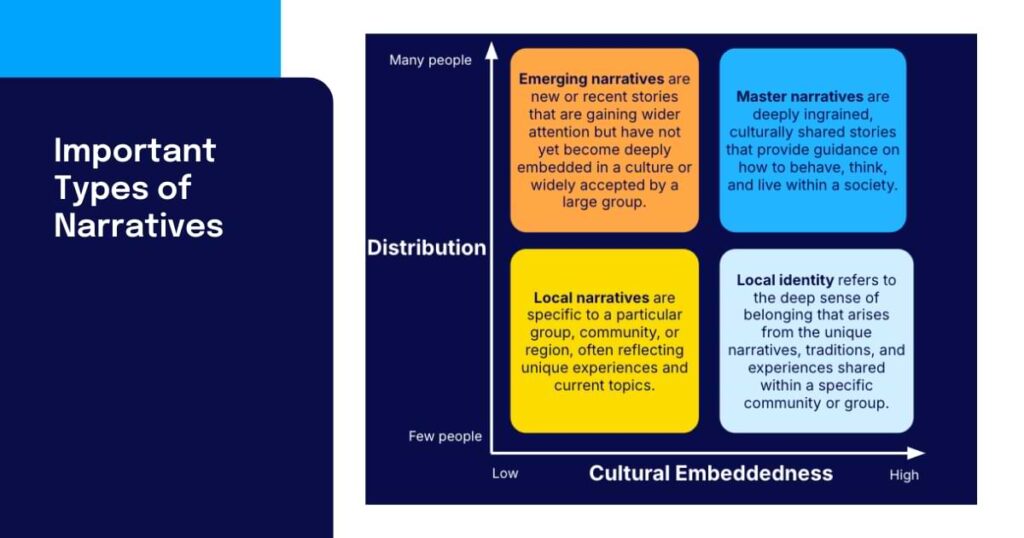
Examining a narrative map example
Each type of narrative in the narrative map can better be understood by examining the perception of AI. But first, here’s a handy tip: if you ever feel stuck when it comes to generating strategic narratives for a narrative map, try to assuage your potential mistrust of AI and instead use it as a tool. I find that AI is great for finding narratives. Here’s an example I typed into ChatGPT to start generating ideas for my narrative map:
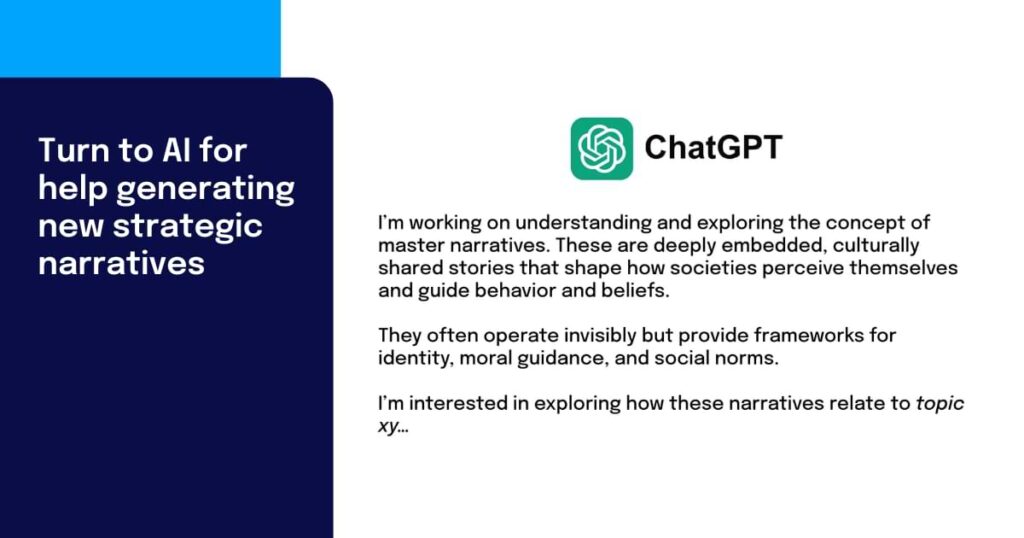
I then used the information to create a narrative map for AI, which you can view below.
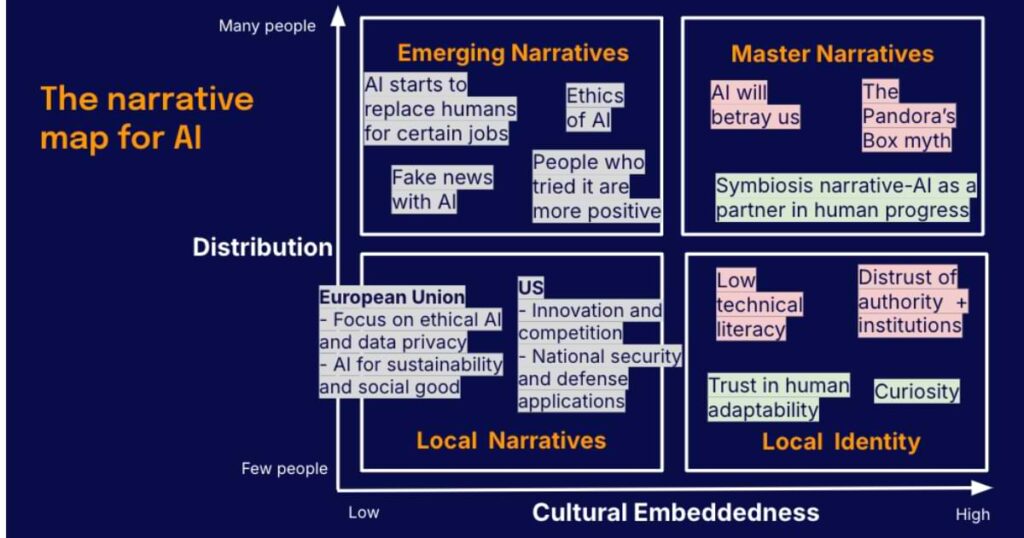
Creating this narrative map provides me with valuable insight into how consumers view AI. It allows me to put myself in numerous vantage points and see from multiple perspectives. These are all important POVs to consider when creating a narrative because each existing narrative will influence how my message is received. And remember, a narrative is only effective if it is understood as it was intended.
Ultimately, it’s critically important for communications to understand the narrative map of their audience. Doing so sheds light on which narratives can be changed and which are too deeply ingrained in audience perceptions.
How to create a narrative map for your company
Creating a narrative map is most effective when considering the existing narratives of an audience. It allows you to consider multiple ways to engage with an existing audience and form a concrete connection. Additionally, a narrative map is a tool that can evolve, be revisited, and be edited multiple times.
How can you create a narrative map for your organization? Consider the types of narratives in a narrative landscape and ask yourself the following questions.
Sample questions for creating a narrative map
Stories/narratives from us: What does the organization say about itself? This might be founding stories or stories about leaders, changes, or current challenges. This includes all perspectives from the past, the present, and the future.
Stories/narratives about us: What are others saying about us? This might include customers, investors, the press, or discussions on social media.
Related cultural stories/narratives: Which current events or topics are potentially relevant to our subject? Which major trends will likely come our way? What is being said about our industry?
Black holes: Which stories or narratives are potentially controversial and might harm our message?
Master narratives: Which biographical, structural, or episodic master narratives can be identified to support or oppose our message?
Local narratives and identity: Who are our key stakeholder groups and are there specific topics they care about?
Overall, the process of creating a narrative map is relatively straightforward, though it involves both creative and critical thinking. Start by defining your strategic narrative and mapping out the narratives that are relevant to your company. Then, map how these stories interact with each other. Next, ensure that the narratives you map out align with your company’s vision and goals. Lastly, keep track of emerging narratives and how they may impact your narrative map.
Don’t forget to adapt your narrative map as the narratives surrounding your business are altered. Remember, each story that compiles to influence a narrative adds to its perception.
Using your narrative map for business strategy
A narrative map truly helps guide everything from marketing to product development. For example, a company needs to communicate a major change to its employees. They are launching a product into a new market. A response is needed in a crisis. A political campaign requires a strategy. The possibilities are endless.
Narrative maps are important tools for driving change. They also help us understand and define new narratives. Through understanding the narrative landscape we can both:
Connect new narratives and stories to existing master narratives
Either challenge directly with a counternarrative or use a more powerful alternative narrative
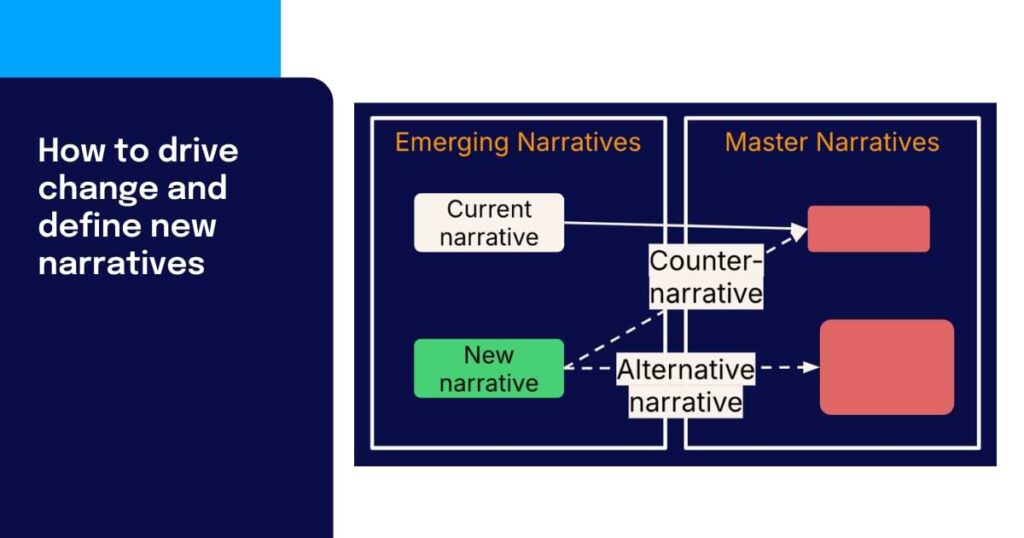
Always ask yourself, is there a more powerful master narrative that we could connect to? For a specific example of a master narrative in action, let’s look at the logistics company DHL. Two strategic narratives we can map for the intersection of AI at DHL are:
The Hero’s Journey Narrative: AI as the supportive guide in DHL’s heroic journey toward a world of sustainable global logistics
The Symbiosis Narrative: Emphasize the harmonious relationship between humans and AI. Focus on how the two work together to create a greener, more connected world.
Now let’s look at the symbiosis narrative: AI and humans are working together for a greener, connected world. This narrative can be fleshed out and thus appeal to an audience by focusing on human-centric technology, appealing to a broader audience (customers, employees, and investors), and addressing ethical and responsible leadership.
As you can see, the mapping process has already shed light on how DHL can better connect with its customers when approaching the tricky topic of AI. When creating your narrative map and crafting your master narrative, ensure that you are considering the most strategic messages that audiences can best connect with.
Remember: Narratives help to identify and connect to emerging stories. You must understand these connections to compose convincing narratives.
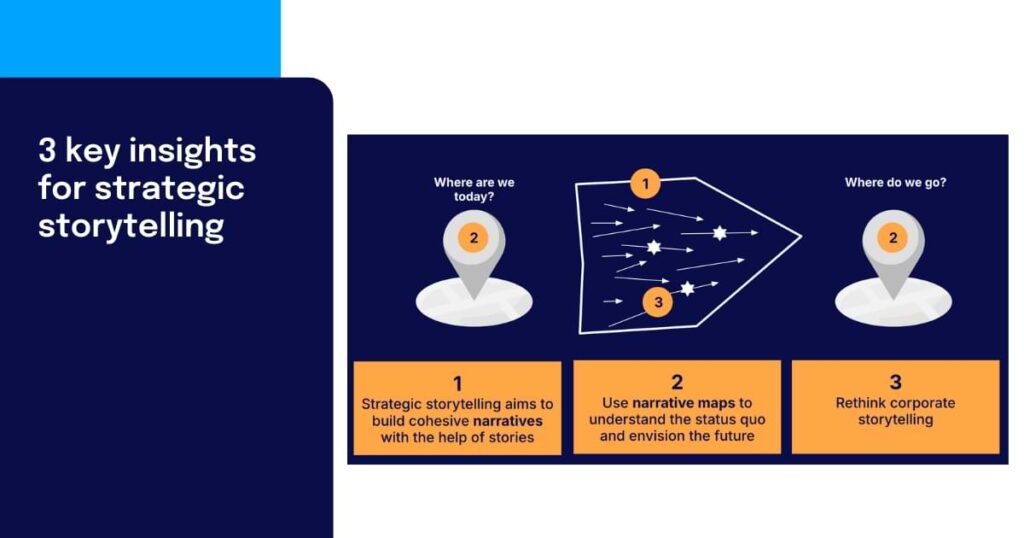
Concluding words on narrative maps
Master your narrative landscape, and you control your company’s future. Ignore it, and someone else will write your story. Creating narrative maps enables communicators to understand their mission and value statements better and connect with their audiences. They are then able to adjust their strategies based on shifts in their narrative landscape and measure the outcome of the narrative.
Remember that narratives are dynamic and evolving. That means your narrative map will require constant adaptation and attention to ensure alignment with a company’s long-term vision. However, this is the best strategy when it comes to creating messages that correctly resonate with audiences and meet company goals. Your message will not have the desired impact if you aren’t aware of the narrative landscape when compiling your communications.
For more information about how to harness the power of narratives, as well as the creation of narrative maps, I invite you to check out my book The Narrative Age. In the meantime, I hope you are ready to answer this question: what’s your company’s narrative? I invite you to start mapping it today and take control of your company’s perception.









